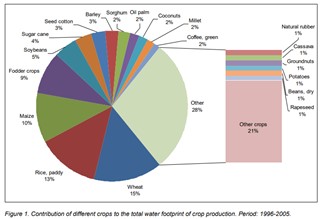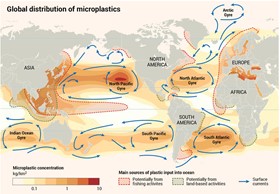28 Aug
Addressing Women Inequality, Pre-requisite for women empowerment
- In news: The World Economic Forum (WEF) has released the Global Gender Gap Report and the Global Gender Gap Index 2021 (India in 2021 has slipped 28 places and has been ranked 140thamong 156 nations).
- Trends in gender inequality:
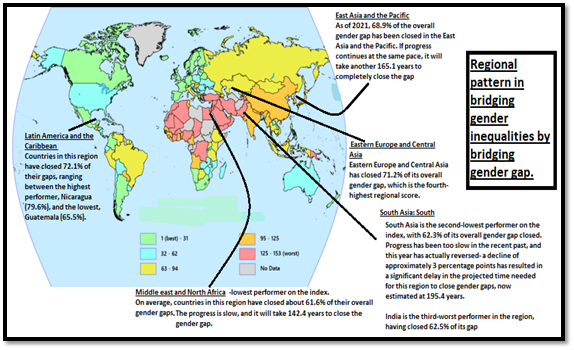
- Background:
- Gender inequality is a part of Feminist geography which developed with an objective to investigate, reveal, challenge, and change gendered divisions in society. It aims to incorporate positions of race, class, ability, and sexuality into the study of geography.
- Women and girls represent half of the world’s population and therefore also half of its potential. But, inequalities faced by girls can begin right at birth and follow them all their lives.These inequalities translate into lack of access to skills and limited opportunities in the socio-economic sphere.
- Therefore advancing gender equality is critical to all areas of a healthy society, from reducing poverty to promoting the health, education, protection and the well-being of girls and boys.
- Thus, resulting into women’s and girls’ empowerment which is essential to expand economic growth and promote social development.
- Regional causes of gender inequality:
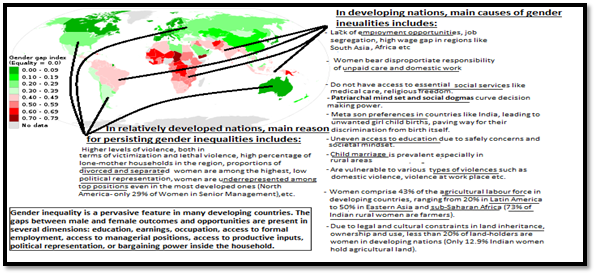
- Covid impact on gender inequality: ILO estimates- 5% of all employed women lost their jobs versus 3.9% of employed men.
- Women are employed in sectors disrupted by lockdown and social distancing measures, and experienced both higher unemployment rates and a subdued re-entry into employment.
- “Doubleshift” phenomena:. The overlap of work responsibilities and care (housework, childcare and eldercare) responsibilities have intensified during the pandemic- contributing to widening labour force participation gender gaps.
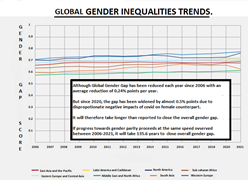
- Consequences of gender inequalities: Discrimination against women from or even before birth guarantees women a marginal role in society, and ensures that they are poorer, less educated, high dependence on male counterpart, facing more unemployment and other such as:
-
- Health risks such as -high maternal mortality, high prevalence of anaemia,
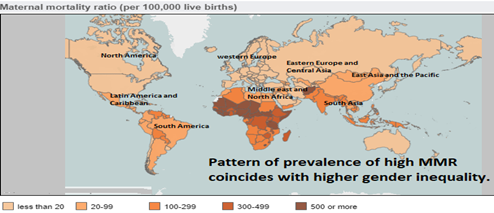
-
- Female foeticide and infanticide (missing girl- indicates a shortfall in the number of women relative to the expected number),
- Child labor (There are currently 152 million children engaged in child labor around the world),
- Gender based violence (1 in 3 women globally have experienced physical or sexual violence in their lifetime) etc.
- Case study: Sub Saharan Africa
In sub-Saharan Africa Gender inequality can be seen in gaps in opportunities (education, legal system, access to finance) as well as outcomes (employment and political empowerment).
These inequalities results in following:
-
- Sexual discrimination and abuse, intimate violence, political marginalization, and economic deprivation.
- According to the World Bank, lack of marketable skills contribute to low female employment within the formal economy. Approx 8 percent of women in the region are illiterate and 85% of working women are considered to have insecure informal jobs.
- The TFR of sub-Saharan Africa at 7 births per woman in 2015–2020, more than twice the level of any other world region (UN). For example: Nigeris the country with the highest fertility rate in the world followed by Mali.
- Sub-Saharan Africans suffer from the highest maternal mortality ratio – 533 maternal deaths per 100,000 live births.
- Prevalent child marriage- on average, nearly 40 percent of girls marry before age 18 and without progress to prevent it, the number of girls married as children will double by 2050. Example: Nigerhas the highest overall prevalence of child marriage in the world.
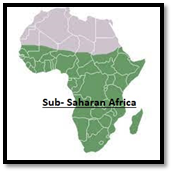
- Will addressing gender inequality empower women?
Empowerment involves gaining power and control over one’s own life. Empowerment of women and girls involves awareness-raising, building self-confidence, expansion of choices, increased access to and control over resources and actions to transform the structures and institutions which reinforce and perpetuate gender discrimination and inequality
Women are social capital and guaranteeing equal rights and giving them opportunities to reach their full potential is critical not only for attaining gender equality, but also for meeting a wide range of international development goals like SDG5, SDG 10. Empowered women and girls contribute to the health and productivity of their families, communities, and countries, creating a ripple effect that benefits everyone.
-
- Empowerment is a process of expanding freedoms equally. Closing the gap is as much a part of empowerment and development as is reducing income poverty. Greater gender equality also enhances economic efficiency and improves other socio-political outcomes.
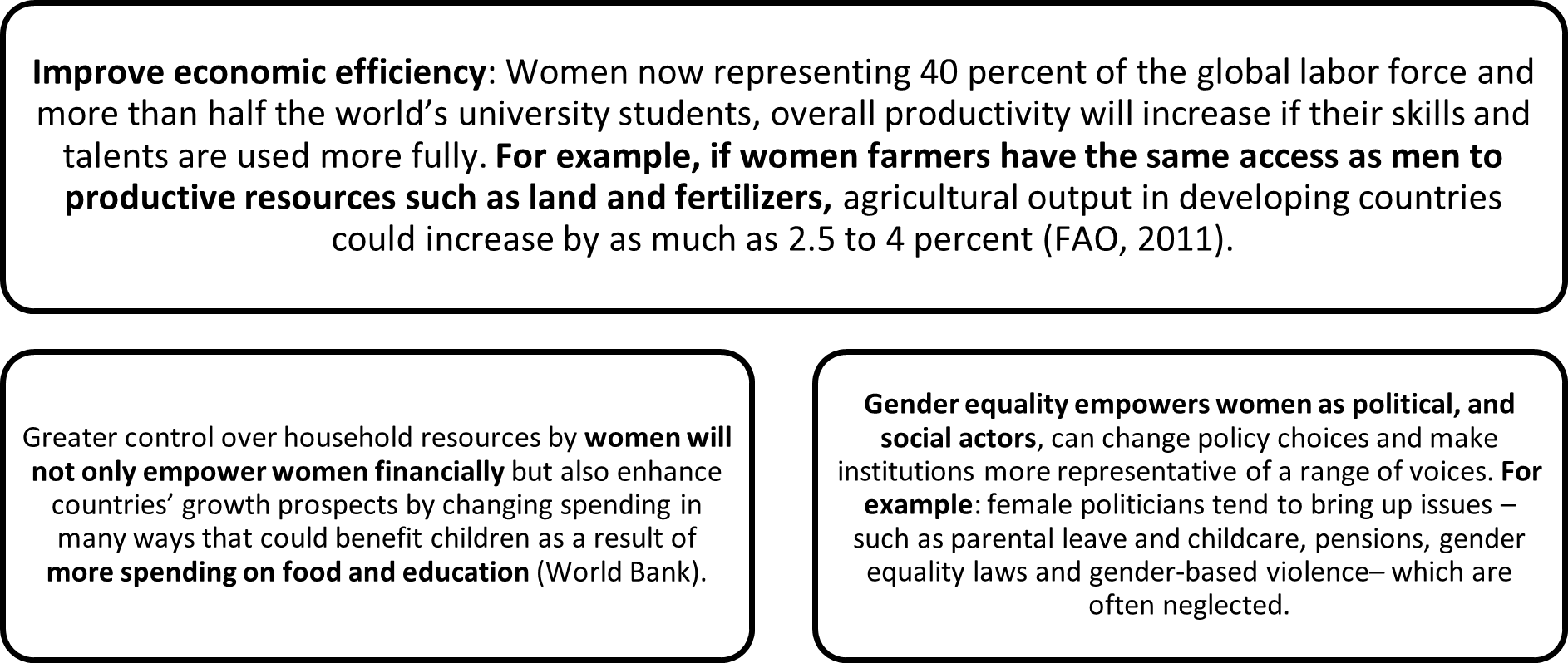
-
- Women’s empowerment is central to realizing women’s rights and gender equality. Women’s empowerment includes women’s ability to participate equally in existing markets, access over productive resources, access to decent work, control over lives and bodies and meaningful participation in economic decision-making at all levels and Gender equality empowers women with higher levels of decision-making power.
- Gender equality translates to better socio-economic outcomes: Women’s empowerment enhance decision making power which translates to other positive development in outcomes such as TFR, MMR, nutritional and micro-nutritional parameters in women and children. Example: According to the World Bank, the female literacy rate in South Asia has increased from 45.5% in 2000 to 57.0% in 2010 while a decreased trend of total fertility rate (i.e., number of children born per woman) was observed from 6.0 in 1960 to 2.6 in 2014.
- Equal education opportunities: Better educated women tend to be more informed about nutrition and healthcare, have fewer children, marry at a later age, and their children are usually healthier. They are more likely to participate in the formal labor market and earn higher incomes. All these factors combined can help lift households, communities, and countries out of poverty.
- Case study: Kerala: Empowered women- better socio-economic indicators
Kerala Government initiatives such as Gender Equality and Women Empowerment policy, Gender Budgeting at local government level, initiatives like Kudumbashree etc, have empowered women socially, economically and financially with greater autonomy in decision making. Thus driving positive change in families and communities:
-
- Highest literacy rates for women in the country ( more than 90% of its women are literate).
- According to NFHS5, Kerala had the highest overall sex ratio — 1,121(number of female births for every 1,000 male births).
- The lowest Infant Mortality Rate (IMR) in the country is expected to be in the State at 9 by 2031-35 and the Total Fertility Rate (TFR) is expected to decline from 1.82 during 2011-2015 to 8 during 2031-35.
- Enhanced participation, leadership, and decision making by women—in the community and within households.
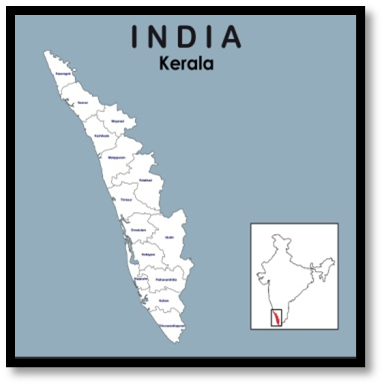
- Way forward:
- Welfare approach to women issues: This is based on Non-discrimination, Ecological parity and well-being, Social justice, Equal status to women, with an aim to seek equanimous positions for all human beings with the good physical quality of life, distributive justice, protection of their natural life i.e. an egalitarian Society.
- Providing equal financial, educational and social resource access like education, digital literacy, credit/financial resources etc. Example: Countries in South America has provisions of cash incentive to women in case of delivery and child education. In India, Pradhan Mantri Matru Vandana Yojana (PMMVY) is a Maternity Benefit Program - providing partial compensation for the wage loss in terms of cash incentives.
- Policy support to generate employment in women dominant sectors like manufacturing, care economy, etc.
- Where it can be used
- Geography
P1 - perspective in human geography, Economic geo, population geo, regional planning.
P2- cultural setting, regional development, contemporary issues
GS- GS1( society), GS2, GS3
Wool Industry in India: Challenges and Prospects
Why in news: Under the National Livestock Mission, the central government approved funds to import Merino breed sheep from Australia to revive our import dependent wool industry.
Wool Industry in India: India’s wool industry is the 7th largest in the world and accounts for nearly 2-3% of total world production. According to the 20th Livestock Census of 2019, India has the 3rd largest number of sheep population in the world with 74.26 million, a 14.1 % increase from the previous census in 2012.
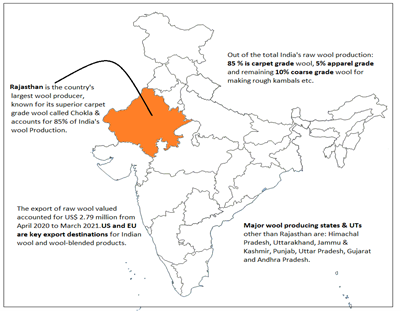
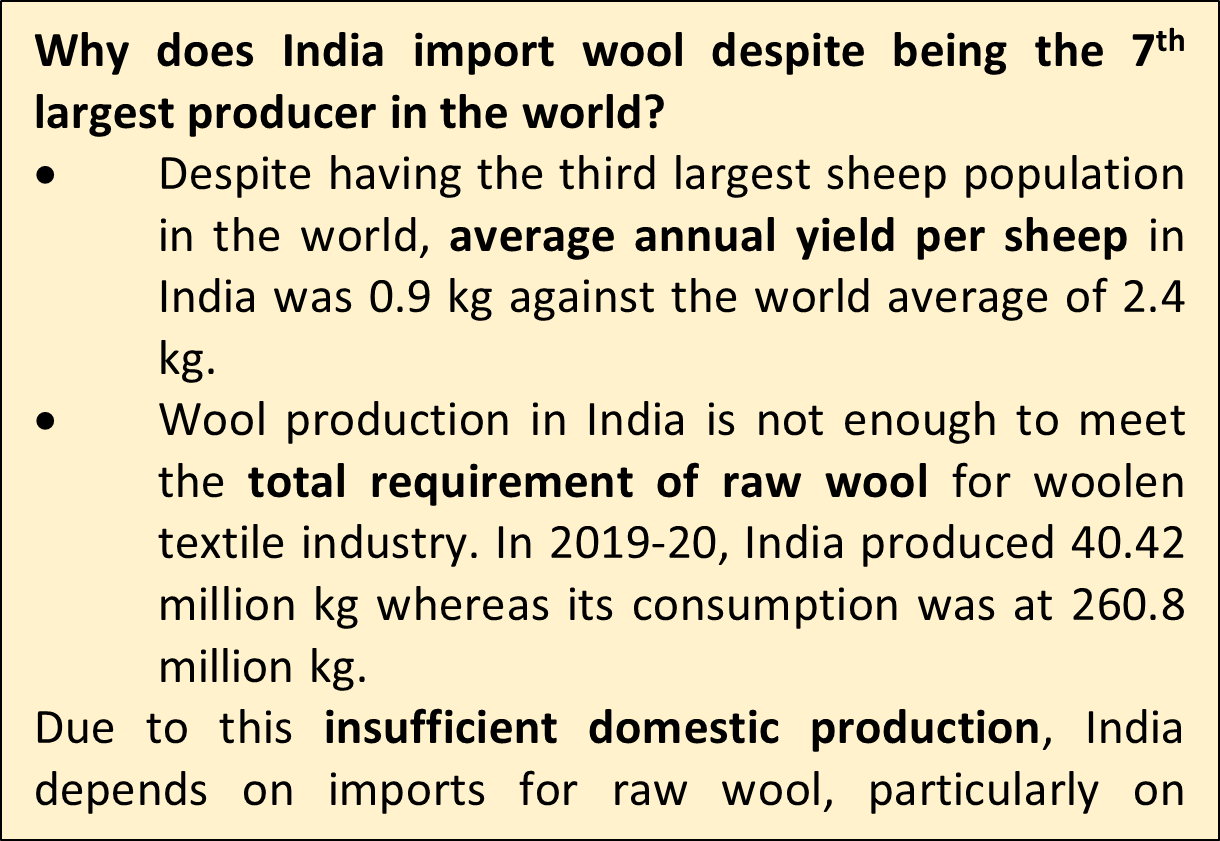
Challenges faced by India’s Wool Industry:
- Union textile ministry in one of its reports on status of wool and textile in India acknowledges that constraints faced by the wool sector are due to:
- Outdated and inadequate pre-and post-loom processing facilities.
- Ineffective role of state wool marketing
- Lack of MSP for ensuring remunerative prices to wool farmers.
- No educational institute for Wool technology.
- Poor quality of Indigenous wool: Bulk of Indian wool is of coarse quality & is used mostly in the hand-made carpet industry. Apparel grade wool accounts for less than 5% of wool production in India.
- Declining Demand for Indigenous wool: In the last 10 years, wool consumption by the country’s processing units increased by 50%, but the use of indigenous wool fell to almost 10% of the total current sales.
- A shift in Farmer’s Focus: There is a shift in farmer’s focus from wool to meat as there is huge demand for sheep meat in local markets. For Instance, Telangana promotes the meat-producing Nellore breed through a subsidized sheep distribution scheme. Also in hilly states like Himachal Pradesh and Uttarakhand, governments supporting sheep meat production through subsidies.
- The decline in Pastures: Pastures are diminishing across India with the increase in plantations as well as urbanization. E.g. in Rajasthan, grazing land fell from 1.7 million hectares (ha) in 2007-08 to 1.6 million ha in 2017-18, according to state agriculture department data.
- Inadequate dyeing facilities and absence of modern practices like machine shearing in the wool potential areas.
The need for revival of Wool industry in India:
- Employment generation: The industry has the potential to generate employment in far-flung and diverse regions and at present provides employment in the organized wool sector to about 12 lakh persons, with an additional 20 lakh persons associated in the sheep rearing and farming sector.
- Rural & Hill area development: The wool industry in India is a source of livelihood for many in the rural areas. Also Indian wool gaining recognition abroad especially Pashmina and angora wool. Thus revival of wool industry can lead to development of backward and hilly areas of Uttarakhand, Jammu Kashmir, and Rajasthan etc.
- Reviving of wool industry can also fetch additional income for farmers and helps in achieving the goal of Atma Nirbhar Bharat.
- Reviving of wool economy can also help in empowering women of rural and tribal areas.

- Drought prone/dry region development: The wool economy can empower drought prone and dry land regions such as Bundelkhand, Western Rajasthan and Ladakh where traditional crop cultivation is not possible.
- Agricultural diversification: Reviving of wool economy also leads to agricultural diversification which is a must needed adoption for sustainable development especially during the era of climate change.
Government Initiatives to support India’s Wool Industry:
- It was proposed to bring sharp focus on entrepreneurship development and breed improvement in sheep and goat under National Livestock Mission (NLM).
- Several schemes such as Integrated Wool Development Programme (IWDP), Scheme for social security for sheep breeders and Scheme for human resource development in Wool sector were initiated by the Central Wool Development Board (CWDB).
- Wool & Woolens Export Promotion Council (WWEPC) for promoting export of all type of wool products from India.
Way Forward:
The wool industry has great potential and it should be realized by using superior sheep breeds, innovations, modernization and facilitations such as Strong wool value system of Newzeland, Wool Innovation Mission of Australia who are the pioneers of wool economy. India can make the sector organized by setting up mega wool apparel parks and common infrastructure for the wool industry.
Where it can be used?
Paper 2 (Livestock resources, Rural area development, Hill area development), GS1 (Poverty and Developmental issues), GS3 (Economics of animal rearing).
Sources:
India’s Population control policies and trends
Why in News:The Uttar Pradesh government unveiled the new population policy 2021-2030 recently, in a bid to reduce the gross fertility rate among women to 2.1 by 2026 and to 1.9 by 2030 in the State.

Presently, India’s population stands at nearly 134 crore. According to the UN Department of Economic and Social Affairs estimates, India’s population will reach 1.5 billion by 2030. Further, the population will hit 1.64 billion in 2050.

Need for population control measures :
- To harness the demographic advantageand realize economic goals of the country. Due to the Population explosion the rights to clean air, drinking water, health, nutritional security, livelihood and education cannot be secured to all citizens without controlling the population.(Malthusianprediction that world’s population would grow at a faster rate than the rate of food production.)
- Helps in reducing fertility rates, thus reduction in unemployment which aligns with Big Push theory which states that population growth tends to erode incomes.
- Improve overall better living standards. Population control can help reduce carbon emission in India and help alleviate climate change.
- Scarce resources like water, clean air, oil etc. can be shared well. The government can increase the quality of services as there are less people to satisfy.
Challenges with the population control policies/Shortcomings:
- Two-child policies are known to disproportionately impact the most vulnerable, particularly women and girls.The vastly differing rates of fertility among states paired with differences in economic growth will also affect inter-state migration.
- It may lead to an increase in gender inequality through sex-selective abortions, malnutrition;families may give up children for adoption to avoid disqualifications in elections/politics.
- Stringent population control measures have landed China in a human crisis that was inevitable.
Suggestions to control population:
- Technology and innovation; Technological change holds out the promise of rising global income levels.
- Sex education;Abstinence, Rhythm method and Birth control.
- Women Empowerment;improve literacy rates, reproduction rights (Improved access to birth control), economic and social rights.
- Nudge: Government can come up with a law withholding benefits from three-child families.
- Urbanisation: more a society urbanizes and the more control women exert over their bodies, the fewer babies they choose to have.
- Transitions in population growth can be understood by Demographic transition model which is based on historical population trends of two demographic characteristics – birth rate and death rate– to suggest total population growth rate cycles through stages as that country develops economically.
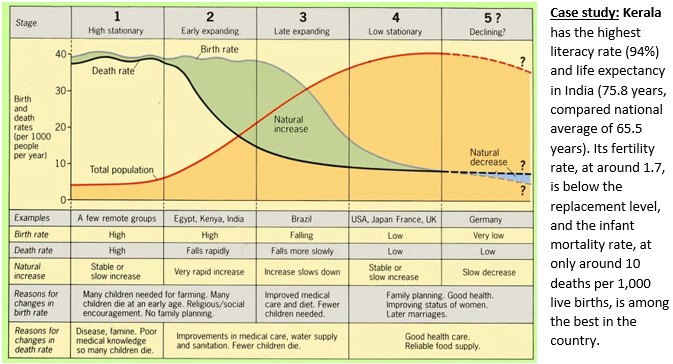
Case study: Kerala has the highest literacy rate (94%) and life expectancy in India (75.8 years, compared national average of 65.5 years). Its fertility rate, at around 1.7, is below the replacement level, and the infant mortality rate, at only around 10 deaths per 1,000 live births, is among the best in the country.
Lessons from Neighborhood:
- Sri Lanka brought down its fertility rate via greater investments in girl-child education and a robust family planning programme. Bangladesh did so by expanding the basket of contraceptive choices available to men and women.
- Therefore being a signatory to the International Covenant on Civil and Political Rights (ICCPR), India has to abide by the international norms on population control. The Human Rights Committee of the United Nations has categorically mandated that state parties to ICCPR cannot adopt policies that are compulsory, coercive or discriminatory.
Biophilic Urbanism
- Biophilic Urbanism (BU) is a concept in urban planning which emphasizes on integrating natural systems into the fabric of cities.
- The objective is to make cities more resource efficient, ecological and sustainable. Such cities are called as Biophilic Cities.
- Components of BU: It involves a series of science and engineering approaches that mimic natural systems within denser urban environments such as integrated green walls and green roofs as biophilic facades on buildings, integrated water management approaches which allow for local infiltration, community gardens and horticulture parks etc.
- The need of BU: Haphazard urban growth, urban pollution, rise of urban micro climates, loss of citizen’s connectedness with the nature and several studies showing that “we are likely to be more resilient, more creative and more generous when we work in the presence of nature as nature is not optional but essential”.
- This concept is similar to the Garden city concept of Howard. But the latter is more of an ideal approach and includes several utopian elements whereas biophilic urbanism is a more practical
- Examples: Singapore was a pioneer in implementing Biophilic urbanism into its urban fabric. Other examples include: Arlington of Virginia, Austin of Texas and Barcelona of Spain.
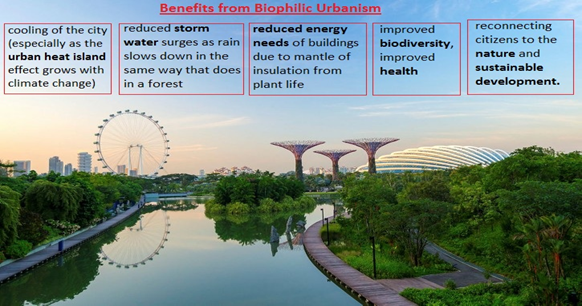
Sources:
- Biophilic Urbanism- a case study of Singapore
- Biophilic urbanism as a tool for ecological and resource efficient cities
- Biophilic design for multiple urban benefits
Image Sources:
KAREZ SYSTEM
Karez systemis an irrigation technology, constructed as a series of well-like vertical shafts. They are connected by sloping tunnels, which tap into subterranean water in a manner that efficiently delivers large quantities of water to the surface by gravity, and do not need for pumping.
Background: The karez cultural landscape of Balochistan represents the "combined works of nature and man", a living heritage tradition of great longevity in a harsh land where groundwater is vital to agro-pastoralist and sedentary agriculture. It follows the functional approach to community-based water management in an arid landscape.
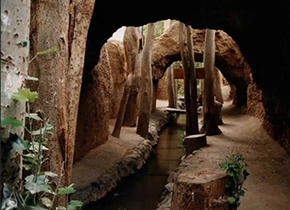
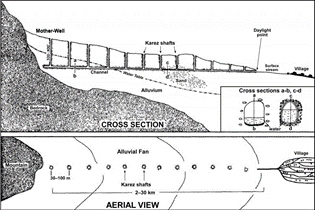
Similar technology is found in India, especially in the northern Kerala and southern Karnataka. They are locally known as surangam.
Importance: Karez allow water to be transported over long distances in hot dry climates without loss of much of the water to evaporation. The system has the advantage of being resistant to natural disasters such as earthquakes and floods, and to deliberate destruction in war.
Why in news: After the start of the second regime of the Taliban in Afghanistan the fate of the karez system is in doubt, though the experts believe that they will restore it as this system is important for the water resource availability in the region.
Source:
- Karez System Cultural Landscape
- Fate of Afghanistan’s karez system uncertain, but south India’s surangam thriving
Image Source:
Albrecht Effect
- It is also called as Cloud Lifetime Effect. It is a phenomenon wherein an increased aerosol concentrations over the oceans leads to an increase in the amount of low-level cloudiness.
- Aerosol particles serve as cloud condensation nuclei (CCN) for water vapour in the atmosphere. Atmospheric water molecules are drawn to aerosol particles like magnets, forming water droplets and eventually creating a cloud.
- Additional aerosols from anthropogenic activities happen to produce more cloud droplets but of smaller sizes. This phenomenon is known as the ‘first’ aerosol indirect effect.
- The resulting increase in the global albedo would be in addition to the increase due to enhancement in reflectivity associated with a decrease in droplet size and would contribute to cooling of the earth surface.
- High concentrations of CCN also may delay the formation of drizzle (the precursor of precipitation), which would increase cloud lifetime and cloud height. This phenomenon is called the ‘second’ aerosol indirect effect known as Albrecht effect.
- So, we can say that aerosol-rich air masses generate clouds that are bigger, brighter, and longer lasting.
- Effect on climate:Clouds with longer lifespan have a cooling influence on climate due to increased Albedo.
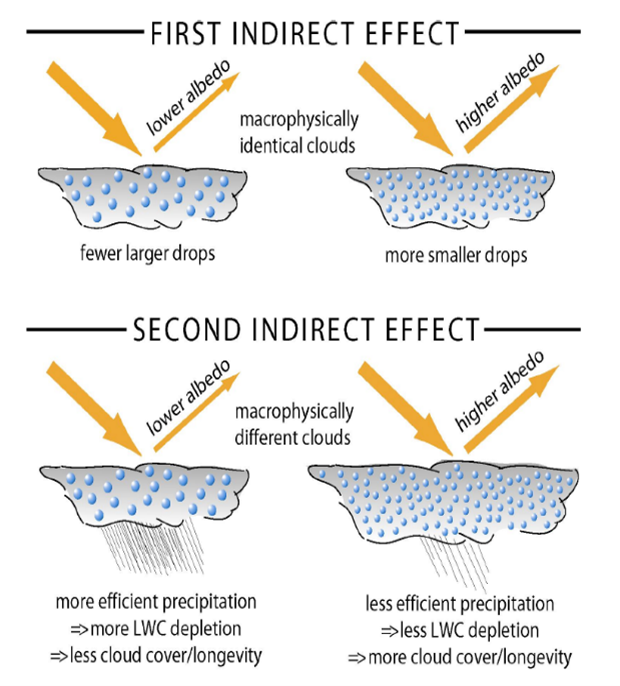
Horticulture based Agroforestry (HBA): Abohar
Background: Abohar is a municipal corporation located in the Fazilka district of Punjab. It falls under the command area of Indira Gandhi Canal (Nahar). Majority of population in Abohar and IG canal catchment area lives in rectangular pattern of settlements. Several challenges faced by Abohar are as follows:
- Water scarcity: Abhor is part of the dry region with very short rainy season. Along with this, water-guzzling paddy cultivation along the IG canal reaches makes the problem much severe.
- Conflicts: Along the IG canal, as the journey of water lengthens, the demand goes up. Along with prosperity, IG canal brings conflicts and competition over the increasingly scarce water.
- Water logging & soil salinity: Intensive irrigation provided by the IG canal and extensive use of fertilizers during Green Revolution has led to the emergence of twin environmental problems of water logging and soil salinity.
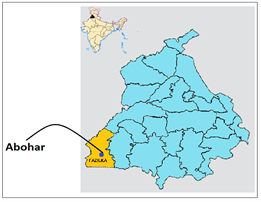

Steps taken to promote Horticulture based Agroforestry in Abohar:
- Under Agricultural diversification mission of Punjab government, stress has been laid to increase the area under horticulture cultivation. Also the farmers have been offered subsidies to the tune of Rs 20,000 per acre for opting horticulture under the National Horticulture Mission.
- Establishment of Krishi Vigyan Kendra (KVK) at Abohar to impart technical knowledge to farmers regarding agroforestry and other agricultural technologies.
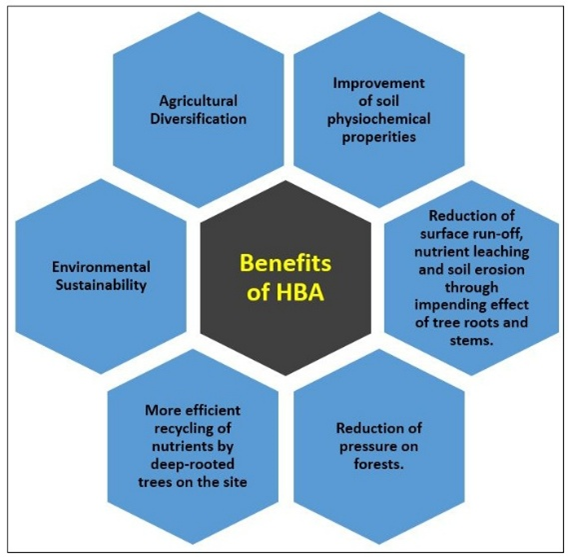
How Horticulture based agroforestry helped the farmers of Abohar?
- Improved income for farmers in the drought prone region due to improved and sustained agricultural productivity.
- Water resource conservation with the efficient use of drip irrigation.
- Improved economic growth and jobs as fruit trees have huge potential not just for nutrition-providing juice but also for their use in pharmaceutical and cosmetic industries.
- Improved soil conditions and ecological conditions of the region.
- Improvement in nutrition and health due to increased quality and diversity of food outputs.
This can be replicated in other drought prone and water stressed regions of Haryana, Punjab, Rajasthan and Bundelkhand.
Where this case study can be used?
This case study can be used in topics related to Paper 1 (Soil Conservation, Sustainable development), Paper 2 (Water resources, Agro forestry, cropping pattern, Rural and Drought prone area development).
Sources:
Places in news
|
Raimona National Park:
|
|
Sao Jacinto Island:
|
|
Thol Lake:
|
|
Buxar:
|
|
Nelong Valley:
|
|
Thiruvananthapuram:
|
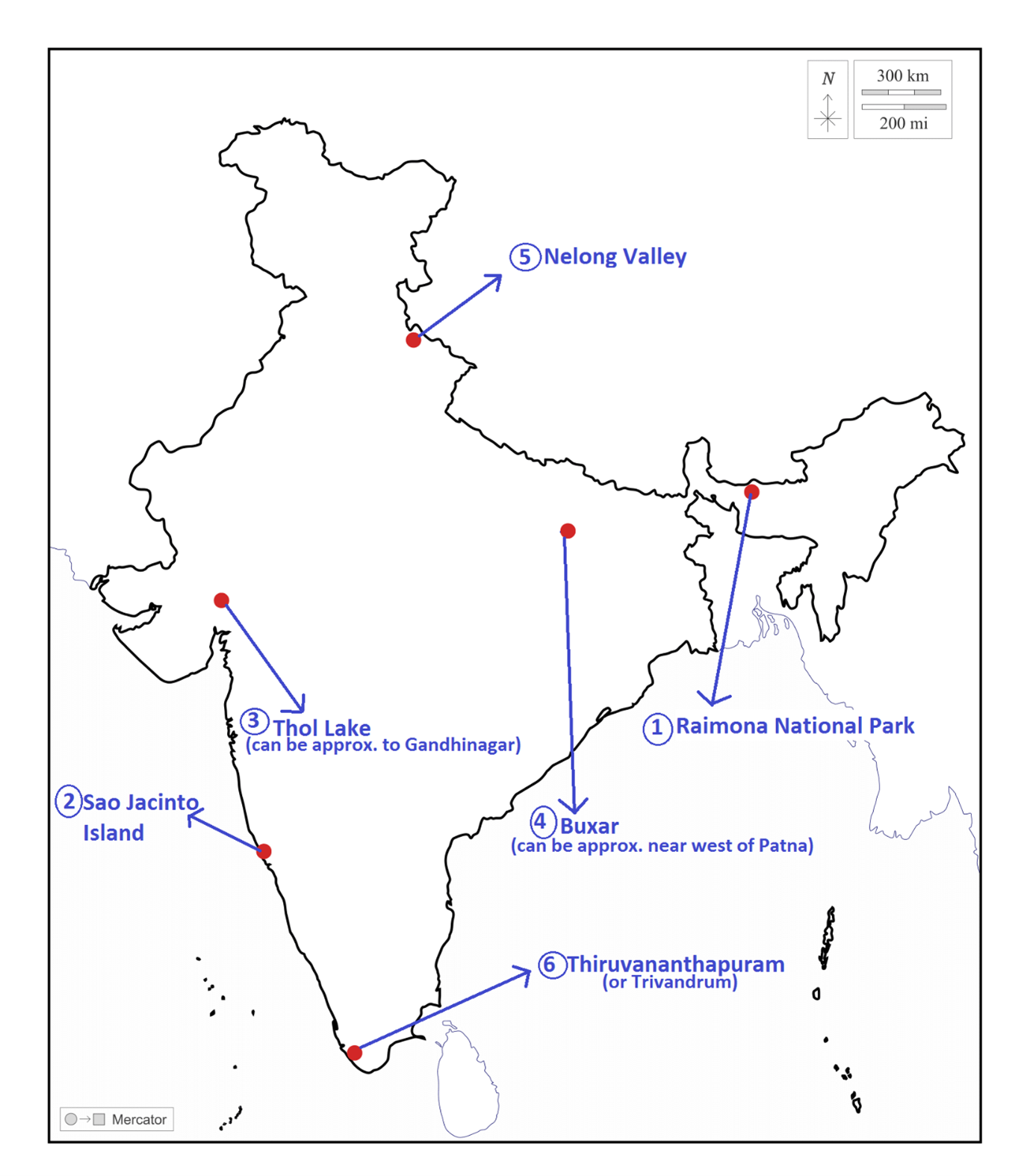
Share the article
Get Latest Updates on Offers, Event dates, and free Mentorship sessions.

Get in touch with our Expert Academic Counsellors 👋
FAQs
Geography Current Affairs focuses on the contemporary issues, events, and developments in the field of geography. It covers recent geographical phenomena, environmental changes, geopolitical shifts, and related news. This differs from regular geography studies which may focus more on foundational concepts, historical contexts, and theoretical frameworks.
Updates are provided regularly to ensure that subscribers stay informed about the latest developments in geography. Typically, updates are provided on a fortnightly basis, depending on the frequency of significant events and changes in the field.
Absolutely. Geography Current Affairs serves as a valuable resource not only for Geography optional but also for GS papers, especially GS Paper 1 (covering Indian Heritage and Culture, History, and Geography of the World and Society) and GS Paper 3 (covering Technology, Economic Development, Biodiversity, Environment, Security, and Disaster Management). It aids in building a holistic understanding of various topics and strengthens answer-writing skills by incorporating contemporary examples and perspectives.
Geography Current Affairs holds immense importance for UPSC preparation, particularly for aspirants opting for Geography optional. It helps candidates stay updated with the latest developments, geographical phenomena, environmental issues, and geopolitical shifts worldwide, aligning them with the dynamic nature of the subject as tested in the UPSC examinations.



